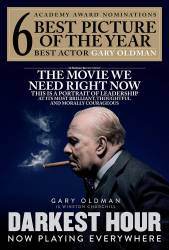Corrected entry: A quartz clock is shown (it being quartz can be understood by the movement of the second hand, jumping each second). It was only in the 1960s that the development of cheap semiconductor digital logic made their public and domestic use possible - their use before that was limited to some specific applications (like some scientific laboratories and so on).

Darkest Hour (2017)
1 corrected entry
Directed by: Joe Wright
Starring: Gary Oldman, Kristin Scott Thomas, Lily James, Ben Mendelsohn
Factual error: When flying to France to have talks with the French premier a C47/Dakota is shown in the background intimating that it was the plane he came in. The C47 did not enter service with the RAF until after this period of the film with Lend Lease.
Suggested correction: The aircraft could just as easily be the civilian version, the DC-3 which first flew in 1935, and was pressed into RAF service and repainted.
The RAF did not requisition civilian DC3s or DC2s. It is well recorded that Churchill flew to France in May 1940 in a de Havilland DH.95 Flamingo. Only 16 were built - de Havilland cancelling DH.95 production to make more Tiger Moths desperately needed for pilot training. The DH.95's were cannibalised for spares, the last scrapped in 1953, so the film production company may be excused for their C-47 use. Though a Lockheed Lodestar may have been a closer simile.
Winston Churchill: My father was like God. Busy elsewhere.
Question: In the 'War Room' scene, there appeared to be a sheet of plastic or acetate covering the wall with the map of the enemy's movements. Was that premature for plastic to be available in that size for that time frame?
Join the mailing list
Separate from membership, this is to get updates about mistakes in recent releases. Addresses are not passed on to any third party, and are used solely for direct communication from this site. You can unsubscribe at any time.
Check out the mistake & trivia books, on Kindle and in paperback.




Correction: The second hand jumping each second is not unique to quartz clocks. An escapement providing a second hand that ticks once per second was invented in 1675 and popularised around 40 years later. It became the standard for pendulum clocks. So this clock is behaving perfectly normally for a mechanical clock.